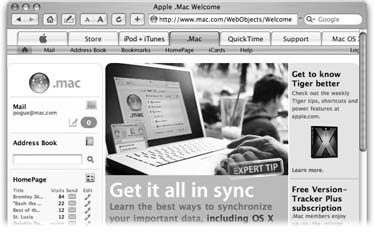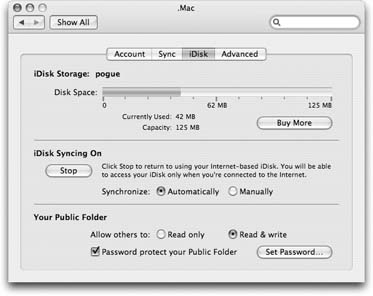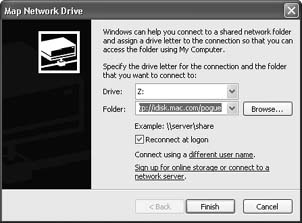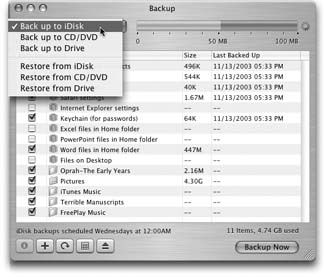19.9. iSync
| < Day Day Up > |
19.8. .Mac ServicesIn January 2000, Apple CEO Steve Jobs explained to the Macworld Expo crowds that he and his team had had a mighty brainstorm: Apple controls both ends of the connection between a Mac and the Apple Web site. As a result, Apple should be able to create some pretty clever Internet-based features as a reward to loyal Mac fans. Later that same day, the Apple Web site offered a suite of free services called iTools. Then the technology bubble burst. These days, .Mac subscriptions (as they're now called) cost $100 per year. For a full description, see Figure 19-8. 19.8.1. Signing Up for .MacOpen System Preferences and click the .Mac icon. Click Learn More. You now go online, where your Web browser has opened up to the .Mac sign-up screen. Fill in your name and address, make up an account name and password, turn off the checkbox that invites you to get junk mail, and so on. The final step is to return to the Internet pane of System Preferences. On the .Mac tab, fill in the account name and password you just composed , if necessary. You're ready to use .Mac. 19.8.2. iDiskThe crown jewel of the .Mac services is iDisk, which creates a 250 MB hard-drive icon on your desktop. (For more money, you can opt for a bigger iDisk. And it's worth noting that if you use your .Mac email account, your mail messages share that 250 megs.) Anything you drag into the folders inside this icon gets copied to Apple's secure servers on the Internet. Meanwhile, on your end, it appears to work just like a hard drive.
Apple's secure servers on the Internet. Meanwhile, on your end, it appears to work just like a hard drive. In other words, iDisk can be a handy pseudo-floppy or pseudo-Zip drive. Better, in fact; because this backup disk is off-site, if a fire or thief destroys your office and your backup disks, your iDisk is still safe. Furthermore, you can pull the iDisk onto any computer's screen ”Mac or Windows ”at your office, at your home, at your friend's house, so you don't need to carry around a physical disk to transport important files. Best of all, the iDisk is extremely well integrated into Mac OS X. For example, when you're saving a document from within a program, you can save it directly onto your iDisk. 19.8.2.1. Pulling it onto your screenApple must really love the iDisk concept, because it has devised about 300 different ways to pull the iDisk icon onto your screen (Figure 19-9):
At this point, the iDisk behaves like an external hard drive. You can drag files or folders from your hard drive into one of the folders that appear on the iDisk. Note: You can't create your own folders in the iDisk's main window. You must put your files and folders into one of the folders already on the iDisk , such as Documents or Pictures. If you try to drag an icon directly into the iDisk window, or onto the iDisk icon, you'll get an error message. Thereafter, you can retrieve or open whatever you copied to the iDisk. Open one of the folders on it; you can now open, rename, trash, or copy (to your hard drive) whatever you find inside. 19.8.2.2. Making the iDisk fast and synchronizedAs you can imagine, copying files to and from a disk through a phone line (or even a cable modem) is very slow compared to copying them between hard drives on the same Mac. The iDisk has a reputation, therefore, of being very slow. But the iDisk doesn't have to run at the speed of an anesthetized slug. Behind the scenes, Mac OS X Tiger can keep a full, invisible copy of the iDisk's contents on your hard drive. When you add something to the iDisk, therefore, it seems to appear there instantly ”even when you're not online ”because all you've done is copy something onto a secret stash of your own drive. The Mac will begin the process of transmitting the copy to the online iDisk at the next opportunity. In short, you can leave the iDisk's icon onscreen for as long as you like, even when you're offline. To turn on this feature, see Figure 19-10. Tip: If you have more than one Mac in different locations (home and office, for example), you can keep your key files synchronized among all of them by turning on this automatic iDisk syncing on all of the machines. You've burned your last "Take Home" CD! 19.8.2.3. The Public folderIn general, whatever you put onto your iDisk is private and password-protected. There's one exception, however: Whatever you put into the Public folder on any iDisk can be seen, opened, and copied by any other .Mac member. All they need is your member name ”not your password. (Think of the iDisk Public folder as the long-lost twin of the Public folder in your own Home folder.) The Public folder is terrific for storing family photos where anyone who's interested can look at them. It's also handy when you're collaborating; just post the latest drafts of your work in the Public folder for your co-workers to review. To view someone else's Public folder, use one of these techniques (suppose the person's .Mac name is SkiBunny23):
After a minute or so, a new iDisk icon appears on your desktop, bearing that member's name. Double-click it to view its contents. You can copy these files to your hard drive, or double-click them to open them directly.
19.8.2.4. iDisk optionsIf you open System Preferences, click the .Mac icon, and click iDisk, you're offered a few interesting options, along with a graph that shows how full your iDisk is getting. Here, you can also make these changes:
Note: These functions are available to pre-Panther/Tiger people (and Windows people) if they visit www.mac.com, click ".Mac Downloads," sign in, and download the program called iDisk Utility (or iDisk Utility for Windows). 19.8.3. EmailApple offers an email address to each .Mac member. Of course, anyone who's able to get to the Apple Web site probably already has an email account. So why bother? The first advantage is the simple address: YourName@mac.com . And because .Mac is a Mac-only service, the odds are good that you'll be able to claim the name you want. No longer must you be known as bgates28514@earthlink.net . (Cultdom has its privileges.) Second, Mac.com addresses are integrated into the Mail program that comes with Mac OS X, as you'll see in the next chapter. And finally, you can read your .Mac email from any computer anywhere in the world, via the www.mac.com Web site. 19.8.4. HomePageCreating a Web page (an HTML document) isn't difficult. Using a program like Dreamweaver, GoLive, Netscape Composer, Keynote, or even Microsoft Word, you can design the text and graphics for a simple Web page in a single afternoon. It's much more difficult, however, to figure out how to post that Web page ”to hang it on the Internet where the world can see it. To do that, you need special software, several passwords and codes, and a lot of help from your ISP. The .Mac HomePage feature eliminates all that hassle. All you have to do is drag your Web-page documents and graphics into the Sites folder on your iDisk (described in the previous section). Your Web page is instantly available for viewing by the 300 million people on the Internet. Tip: You can create as many Web pages as you want. When you return to the HomePage screen, a list of your existing Web pages appears (complete with Edit Page and Delete Page buttons). If you already know how to design Web pages, great; put the HTML documents and graphics you've created into the Sites folder of your iDisk. Then tell your friends its Web address. Suppose that the Web page you designed is called index.html , and that your .Mac member name is SkiBunny. In that case, your custom-designed Web address is http://homepage.mac.com/skibunny/index.html (although most people can leave off everything after your member name). And if you have no experience designing Web pages, Mac OS X itself can help you:
When you finally click the Publish button at the top of the screen, new Web page (HTML) documents appear in the Sites folder of your iDisk. Also, your screen now displays your page's URL (Web address), which you can email to anyone who'd be interested. Unfortunately, it's not particularly catchy; it's along the lines of http://homepage.mac.com/YourMemberName/baby.html.
Finally, your Web page is available for anyone on the Internet to see. Corporations and professional Web designers may sniff at the simplicity of the result ”but it takes them a lot longer than ten minutes to do their thing. 19.8.5. Backup.Mac membership also includes access to a program called Backup, which can give you an effortless, even automatic backup system for your most important files. It's also among the easiest -to-use backup programs ever written. After you've downloaded the Backup program (from www.mac.com) and installed it, you'll find the Backup icon in your Applications folder. Opening it produces what you see in Figure 19-11. Here's how to back up your stuff:
Tip: If you're backing up onto your iDisk or a hard drive, you can set up Backup to make automatic backups according to a schedule, just by clicking the Schedule Backups button. Backup will kick in at the scheduled time, assuming your Mac is on, your account is logged in, and the Backup program isn't already running. (To find out if your scheduled backup took place, choose File Show Log.) If disaster should ever befall your files ”dead hard drive, clueless spouse, overtired self ”you'll be glad you went through this exercise. Insert the CD or DVD (or connect the iPod, hard drive, or iDisk) and then use the appropriate Restore command from Backup's top pop-up menu. Turn on the Restore checkboxes next to the stuff you want, and then click restore Now. |
| < Day Day Up > |
EAN: 2147483647
Pages: 506




